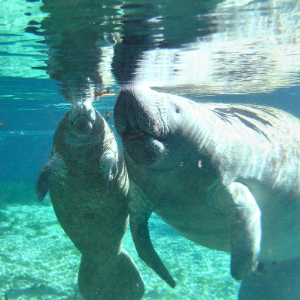By Sandi Schwartz
Four years ago, the U.S. Fish and Wildlife Service announced that manatees, which had been on the endangered list for many years, were doing much better. In fact, in 2017 the manatee was down-listed from an endangered species to a threatened species. But now, manatees swimming in Florida's waterways are dying at an alarming rate. Nearly 700 manatees have perished throughout the state in the last few months. That is almost three times the five-year average of 146 deaths in the period between January 1 through March 5, according to the Florida Fish and Wildlife Conservation Commission.
Why is this happening? Although boat strikes continue to threaten manatees, experts believe that the main reasons so many manatees are dying this year include cold water and starvation. Cold snaps like those we experienced this winter cause manatees to cluster together in warm water areas like shallow lagoons. Without a warm spot with adequate food supply, they cannot survive.
In addition, manatees are becoming malnourished because of a lack of seagrass. Manatees rely on seagrass as their main food source; an adult manatee typically eats over 100 pounds of seagrass each day. Without their primary food source, manatees are literally starving to death. Unfortunately, seagrass is disappearing as a result of development and water pollution. Sewage and fertilizers filled with harmful chemicals like glyphosate are ending up in the local waterways and destroying the seagrass. The glyphosate originates from people's lawns, while the sewage comes from spills and leaking septic tanks. The latest concern is that the polluted wastewater released into Tampa Bay at Piney Point could add another threat to Florida manatees.
Unfortunately, this is an issue happening around the state, including in our local area. At last count, there have been 32 manatee deaths in Palm Beach County, 51 in Broward County, and 15 in Miami-Dade County. The largest number of manatee deaths have occurred just north of our region in Brevard County in the Indian River Lagoon. Much of the seagrass has been destroyed in that area. The Florida Oceanographic Society has been working to grow more seagrass, but the process has not been fast enough to save the manatees this season.
What can you do?
- Avoid using fertilizers and herbicides on your lawn and in your community.
- If you are a boater, slow down, look out for manatees and other wildlife, and stay out of seagrass areas.
- Look for volunteer opportunities to plant more seagrass. Check with your local Department of Environmental Protection as well as your local Waterkeepers (Indian River Waterkeeper or Lake Worth Waterkeeper).
- Call Florida Fish and Wildlife Conservation Commission's Wildlife Alert toll-free number: 1-888-404-FWCC (1-888-404-3922) if you see a sick, injured, dead, or tagged manatee.
- Learn more about protecting water in Florida.
